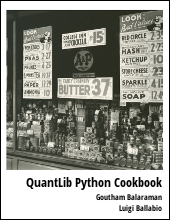An Introduction to Interest Rate Term Structure in QuantLib Python
April 08, 2015 by Goutham BalaramanThis post will walk through the basics of bootstrapping yield curve in QuantLib Python.
Visit here for other QuantLib Python examples. If you found these posts useful, please take a minute by providing some feedback.
Term structure is pivotal to pricing securities. One would need a YieldTermStructure object created in QuantLib to use with pricing engines. In an earlier post on modeling bonds using QuantLib we discussed how to use spot rates directly with bond pricing engine. Here in this post we will show how to bootstrap yield curve using QuantLib.
As usual lets import QuantLib and do some initialization.
import QuantLib as ql def print_curve(xlist, ylist, precision=3): """ Method to print curve in a nice format """ print "----------------------" print "Maturities\tCurve" print "----------------------" for x,y in zip(xlist, ylist): print x,"\t\t", round(y, precision) print "----------------------"
The deposit rates and fixed rate bond rates are provided below. This example is based on Exhibit 5-5 given in Frank Fabozzi's Bond Markets, Analysis and Strategies, Sixth Edition.
# Deposit rates depo_maturities = [ql.Period(6,ql.Months), ql.Period(12, ql.Months)] depo_rates = [5.25, 5.5] # Bond rates bond_maturities = [ql.Period(6*i, ql.Months) for i in range(3,21)] bond_rates = [5.75, 6.0, 6.25, 6.5, 6.75, 6.80, 7.00, 7.1, 7.15, 7.2, 7.3, 7.35, 7.4, 7.5, 7.6, 7.6, 7.7, 7.8] print_curve(depo_maturities+bond_maturities, depo_rates+bond_rates)
Lets define some of the constants required for the rest of the objects needed below.
# some constants and conventions # here we just assume for the sake of example # that some of the constants are the same for # depo rates and bond rates calc_date = ql.Date(15, 1, 2015) ql.Settings.instance().evaluationDate = calc_date calendar = ql.UnitedStates() bussiness_convention = ql.Unadjusted day_count = ql.Thirty360() end_of_month = True settlement_days = 0 face_amount = 100 coupon_frequency = ql.Period(ql.Semiannual) settlement_days = 0
The basic idea of bootstrapping using QuantLib is to use the deposit rates and bond rates to create individual helpers. Then use the combination of the two helpers to construct the yield curve.
# create deposit rate helpers from depo_rates depo_helpers = [ql.DepositRateHelper(ql.QuoteHandle(ql.SimpleQuote(r/100.0)), m, settlement_days, calendar, bussiness_convention, end_of_month, day_count ) for r, m in zip(depo_rates, depo_maturities)]
The rest of the points are coupon bonds. We assume that the YTM given for the bonds are all par rates. So we have bonds with coupon rate same as the YTM.
# create fixed rate bond helpers from fixed rate bonds bond_helpers = [] for r, m in zip(bond_rates, bond_maturities): termination_date = calc_date + m schedule = ql.Schedule(calc_date, termination_date, coupon_frequency, calendar, bussiness_convention, bussiness_convention, ql.DateGeneration.Backward, end_of_month) helper = ql.FixedRateBondHelper(ql.QuoteHandle(ql.SimpleQuote(face_amount)), settlement_days, face_amount, schedule, [r/100.0], day_count, bussiness_convention, ) bond_helpers.append(helper)
The yield curve is constructed by putting the two helpers together.
rate_helpers = depo_helpers + bond_helpers yieldcurve = ql.PiecewiseLogCubicDiscount(calc_date, rate_helpers, day_count)
The spot rates is obtined from yieldcurve object using the zeroRate method.
# get spot rates spots = [] tenors = [] for d in yieldcurve.dates(): yrs = day_count.yearFraction(calc_date, d) compounding = ql.Compounded freq = ql.Semiannual zero_rate = yieldcurve.zeroRate(yrs, compounding, freq) tenors.append(yrs) eq_rate = zero_rate.equivalentRate(day_count, compounding, freq, calc_date, d).rate() spots.append(100*eq_rate)
The bootstrap curve looks as shown below:
| Maturity | Spots |
|---|---|
| 0.0 | 0.0 |
| 0.5 | 5.25 |
| 1.0 | 5.426 |
| 1.5 | 5.761 |
| 2.0 | 6.02 |
| 2.5 | 6.283 |
| 3.0 | 6.55 |
| 3.5 | 6.822 |
| 4.0 | 6.87 |
| 4.5 | 7.095 |
| 5.0 | 7.205 |
| 5.5 | 7.257 |
| 6.0 | 7.31 |
| 6.5 | 7.429 |
| 7.0 | 7.485 |
| 7.5 | 7.543 |
| 8.0 | 7.671 |
| 8.5 | 7.802 |
| 9.0 | 7.791 |
| 9.5 | 7.929 |
| 10.0 | 8.072 |
Once we have the spots, the zero coupon curve can be directly constructed the next time as show in the bond pricing example. The yieldcurve.dates() and yieldcuve.zeroRate(...) methods would provide for the necessary rates as shown above.
Conclusion
In this post we showed how to bootstrap yield curve to get spot rates.
Download the bootstrap yield curve ipython notebook.
python finance quantlib
Related Post
- QuantLib Python Tutorials With Examples
- Modeling Vanilla Interest Rate Swaps Using QuantLib Python
- Valuing Options on Commodity Futures Using QuantLib Python
- Short Interest Rate Model Calibration in QuantLib Python
- Announcing qtk for QuantLib Python

I am Goutham Balaraman, and I explore topics in quantitative finance, programming, and data science. You can follow me @gsbalaraman.

Updated posts from this blog and transcripts of Luigi's screencasts on YouTube is compiled into QuantLib Python Cookbook .